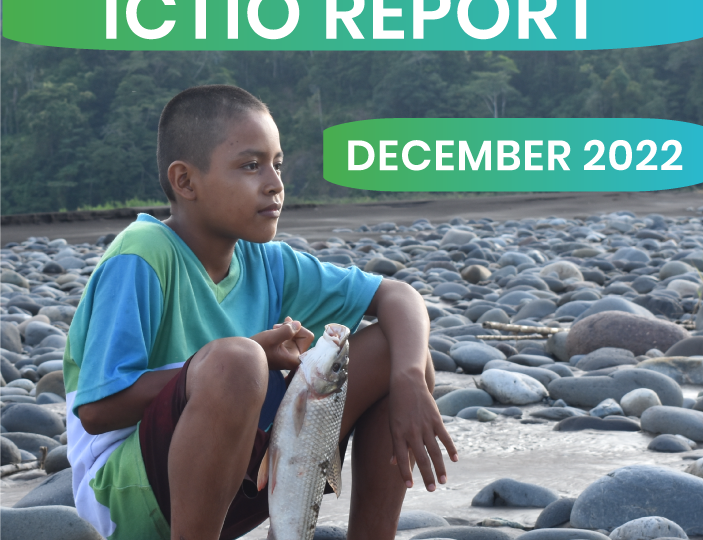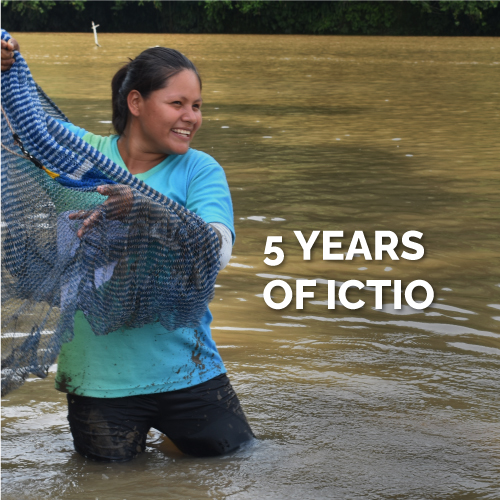
Launched in July 2018, the Ictio platform has enabled people and organizations to participate in recording fish observations across the Amazon basin. These records are made available through the Ictio app (download link) and also the ictio.org website. Today, Ictio has 106,370 observations of 119 species/species groups (Figure 1). Between January and March, 2023, all new observations came from app users (Figure 2), which represents a 0.7% increment in the total number of observations. This slower increase may be related to the closed fishing seasons, when certain species cannot be caught commercially.
Figure 1 – As of March 31, 2023, Ictio had recorded a total of 106,370 fish observations in 61,179 fishing events. This information was generated in 153 (77%) of the 199 level 4 sub-basins of the Amazon, the results of the work of 671 individuals and organizations. Observations were recorded in Ictio from April, 2018 to March, 2023, and the information was consolidated on April 1, 2023. Source: Ictio.org Prepared by: Wildlife Conservation Society.
Figure 2 – As of March 31, 2023, a total of 20,233 fish observations have been shared in 12,442 fishing events via the Ictio app. Observations were recorded in Ictio between April, 2018 to March, 2023, and accessed on April 1, 2023. Source: Ictio.org. Prepared by: Wildlife Conservation Society.
Total observations are distributed across 153 of the 199 level 4 (BL4) sub-basins in the Amazon (i.e. 77%) (learn more about basin classifications in Venticinque et al., 2016 – ‘New Geographic Information System (GIS) on rivers and basins for the conservation of aquatic ecosystems in the Amazon’). The sub-basin ‘Madeira – above Jamari’ retains the lead in the number of records with 16,324 observations (Figure 3). The breadth of coverage of the Ictio’s platform demonstrates that it is a tool with great potential to support decision-making on fisheries management and connectivity of Amazonian rivers.
Figure 3 – The top 10 BL4 level sub-basins with records in Ictio correspond to 74% of the total observations. Observations were recorded in Ictio between April, 2018 and March, 2023, and data was consolidated on April 1, 2023. Source: Ictio.org Prepared by: Wildlife Conservation Society.
The Ictio platform provides reporting on 131 species/species groups, and the option ‘Other fish’ (‘Fish sp’) reports on other species that are not yet in the database. When reporting species using ‘Fish sp’ it is important to note which species are caught in the comment field, in addition to including a photograph, as this allows documentation of the demand for possible future inclusion of new species that are of interest to citizen scientists.
Of the species/species groups recorded in Ictio, the jaraqui (Semaprochilodus insignis) remains the most recorded species (8,564 observations), followed by ‘Other fish’ (‘Fish sp’ – 7,098 observations) and the tambaqui (Colossoma macropomum) with 6,653 observations. Click on this link to see maps of the occurrence of the two principal migratory species for conservation: dorado (Brachyplatystoma rousseauxii) and bocachico (Prochilodus sp); and a graph of the 10 most fished species.
THE DATA COLLECTION COMMUNITY KEEPS GROWING
Currently, the community consists of 671 people and organizations that are sharing fish observations in the Amazon. Between January and March, 2023, the number of app users grew from 645 to 658 people (a 2% increase). The app user with the highest number of records made 746 observations in the region of Loreto (Peru). Twenty-two users use the web upload platform to share monitoring and research databases. Thought is being given to offering an alternative for people who do not have constant access to the internet or mobile phones; alternative analog and digital tools will soon be available to strengthen monitoring on an Amazonian scale.
RECORDING THREATS TO AMAZONIAN FISHERIES
An interesting function of the app is its capacity for sharing fish photos. The photos provide information on the diversity of fish that are the focus of fishing in the Amazon basin, are useful for confirming the observations made by users, for the future identification of species that are not yet in the Ictio database, and also to register threats to Amazonian fishing.
This quarter, we highlight the records of paiche (Arapaima gigas) in the sub-basins of the middle and upper Madeira (in Bolivia and Brazil). The paiche has native distribution in most of the Amazon, where the species is of great cultural and commercial importance. However, in the middle and upper Madeira sub-basins it is an invasive species. Unfortunately, the paiche is in danger of extinction due to overfishing. Below, we highlight Yamil Nay’s photo of paiches caught in the Beni River. Below, we highlight Yamil Nay’s photo of arapaimas caught in the Beni River, Bolivia (Figure 4 – ML458215121 Paiche Macaulay Library).

Figure 4 – Arapaimas caught in the Beni River, Bolivia, where the species is invasive. Credit: Yamil Nay/Macaulay Library at the Cornell Lab (ML458215121).
The arapaima has high commercial value, which could mean increased income for fishers in the area where it is invasive (sub-basins of the middle and upper Madeira); however, it is a large and voracious piscivore, and as an invasive species, it has the potential to threaten native stocks of important commercial fish (you can learn more in these scientific articles by Red partners Carolina Doria ´Is there a future for artisanal fishing in the Amazon? The case of Arapaima gigas’ and Guido Miranda ‘Distribution of arapaima (Arapaima gigas) (Pisces: Arapaimatidae) in Bolivia: implications in the control and management of a non-native population’; and also in the news article ‘Pirarucu (ou paiche): o peixe nativo da Amazônia que virou ameaça em rios da região onde é considerado invasor’).
The expansion of the invasive arapaima and its impacts on riverine ecosystems could be a possible turning point for the complex and interconnected Amazonian ecosystem and needs to be monitored. Ictio can be an important tool in this monitoring.
All maps generated are available below:
GLOSSARY
Checklists: Lists of fish caught in a fishing event.
BL4 Basins: Basin level 4 is the scale that delineates all tributary sub-basins between 10,000 km² and 100,000 km².
Observations: Records of species/groups of fish species caught in the Amazon Basin.
Users: Amazonian citizens using the ICTIO application or platform, consisting mainly of local and indigenous peoples, individual fishers, management groups, associations of fishermen, and scientists.






